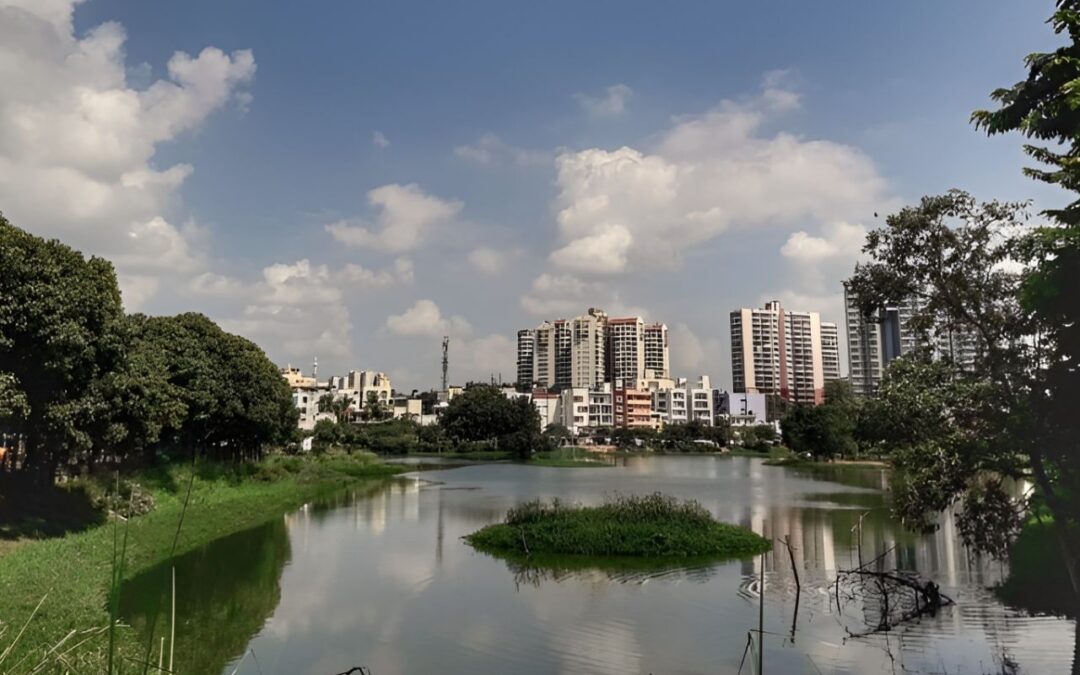Synopsis- Karnataka has taken an unprecedented step towards climate and urban sustainability with the approval of the Karnataka Water Security and Resilience Project (KWSRDP), with an overall cost of Rs. 5000 crores. The KWSRDP will reduce the impacts of flooding in urban areas, water scarcity, and climate-related disasters in Bengaluru and surrounding districts.
Breakdown of the Project
The Karnataka Government has approved the Karnataka Water Security and Disaster Resilience Programme (KWSRDP), funded by the World Bank funding in January 2025. The total cost of Rs 5,000 crores is made of a Rs 3,500 crore loan from the World Bank and a Rs 1,500 crore contribution by the state government. The project is now waiting for final financial approval from the Department of Economic Affairs and for the loan to be signed.
This project seeks to tackle the twin scourges of water shortages and urban flooding that have been occurring with rising regularity and severity in the Bengaluru metropolis. According to government representatives, the project will be initiated on April 1, 2025, with the Revenue Department (Disaster Management) responsible for implementation, and financial structuring being coordinated by the Finance Department.
Urban Flooding and Water Stress
Bengaluru’s hasty growth and climatic unpredictability have resulted in a crisis of extremes-whereas monsoon floods inundate the city’s antiquated stormwater network, the dry season sees acute shortages of water. Poor urban drainage, waterbody encroachment, and lack of wastewater treatment have added to the woes. Most of the main stormwater drains are either unlined or choked, leading to regular flooding and disrupting life, mobility, and public health. KWSRDP caters to these needs through a citywide improvement of stormwater, sewage, and emergency response infrastructure.
Important Infrastructure Elements
1. Stormwater and Flood Management: The BBMP (Bruhat Bengaluru Mahanagara Palike) will make sure to improve Bengaluru’s urban drainage system. As of now, close to 700 km of a planned 1,100 km network of rajakaluves has already been upgraded under different urban development programs. The remaining 300 km would be taken up as part of the KWSRDP, drastically minimizing the city’s exposure to flooding. These improvements include:
- Installing 195 km of new stormwater drains
- Improving 174 km of existing drains
- Building 80 km of stone-lined drain channels
- Building retaining walls, culverts, and U-shaped reinforced concrete drains
2. Sewage and Wastewater Management: This integrated system will expand wastewater treatment coverage and enable the reuse of treated water for non-potable use. To check water pollution and induce groundwater recharging, BWSSB (Bangalore Water Supply and Sewerage Board) will build:
- Nine new Sewage Treatment Plants (STPs) having a total capacity of 148 MLD
- 415 km of buried sewerage pipes
- Several new pumping stations to improve sewage mobility
3. Groundwater Recharge and Irrigation: As part of small irrigation measures, 0.7361 TMC of surplus water from Gopalapura Lake will be routed to recharge 41 lakes in Bengaluru. The measure is likely to assist in recharging groundwater levels and facilitating ecological balance in urban and peri-urban areas. In addition to allocation mentioned below, the state has also committed Rs 2,000 crore towards flood management separately under the umbrella of the KWSRDP.
| Budget Allocation by Department | |||
| Implementing Department | World Bank Loan | State Govt Share | Total Allocation |
| BBMP (Urban Stormwater Infrastructure) | Rs. 1,700 crore | Rs. 300 crore | Rs. 2,000 crore |
| BWSSB (Sewage & Water Management) | Rs. 1,000 crore | Rs. 70 crore | Rs. 1,070 crore |
| Karnataka State Disaster Management Authority (KSDMA) | Rs. 550 crore | Rs. 1,130 crore | Rs. 1,680 crore |
| Minor Irrigation Department | Rs. 250 crore | – | Rs. 250 crore |
| Total | Rs. 3,500 crore | Rs. 1,500 crore | Rs. 5,000 crore |
Also read: Bengaluru’s Real Estate is Booming on Sarjapur Road in 2025 — Here’s What’s Fueling the Surge
Disaster Management and Resilience Building
The disaster preparedness component of the program will be handled by the Karnataka State Disaster Management Authority (KSDMA). This multi-level response mechanism can help decrease loss of life and property in the wake of extreme weather, which has become more frequent in the state. Plans include:
- Upgrading the Karnataka State Natural Disaster Monitoring Centre (KSNDMC) to international standards
- Stepping up emergency operations in 15 flood-hit districts
- Installing landslide prevention and real-time climate monitoring systems
Expected Outcomes
By solving congestion of stormwater, improper management of wastewater, and weak disaster response, KWSRDP hopes to create a water-secure, climate-resilient Karnataka. Expected outcomes are:
- Substantial decrease in urban flooding
- Enhanced sewage treatment capacity and coverage
- Augmented groundwater recharge
- Better early warning systems for natural disasters
- Improved coordination among municipal, state, and global stakeholders
Impact on Real Estate in Urban and Semi Urban Areas
- This step will greatly enhance water reliability and urban resilience, reducing risks that often deter real estate investment in water-stressed areas.
- For realty developers, the move increases the appeal of projects with sustainable water infrastructure, likely boosting premium property demand for gated communities and eco-friendly apartments.
- Overall, stronger water security can raise investor confidence and elevate long-term real estate values in Karnataka’s urban markets.
Implementation Timeline
The project will start on April 1, 2025, and will be implemented in phases over the course of the next few years. It will be implemented by various implementing agencies such as BBMP, BWSSB, KSDMA, and Department of Minor Irrigation. Coordination with the World Bank will be maintained across the project’s life to meet global standards of sustainability. One BWSSB top official stated the project’s sense of urgency:
“Rapid urbanisation and climate change have intensified Bengaluru’s vulnerability to flooding while simultaneously exacerbating water scarcity. The city has been struggling with deteriorating stormwater drainage systems, poor maintenance, traffic disruptions, public health concerns, and significant economic losses. To address these issues, the Karnataka government has partnered with the World Bank to introduce the Karnataka Water Security and Disaster Resilience Program. This comprehensive initiative focuses on improving rainwater management infrastructure, constructing efficient drainage systems, treating and reusing wastewater, and strengthening local disaster management agencies.”
Conclusion
The Rs. 5,000 crore Karnataka Water Security and Resilience Project is not simply an infrastructure project; it’s a master plan for a sustainable future city. Backed by a good policy framework, solid technical implementation, and international financial support, Karnataka is creating a national standard for climate-resilient urban planning and disaster risk reduction. As the state prepares for implementation, the world of urban planners, greens, and citizens from all over India will be paying close attention.
Written by Adithya Menon





